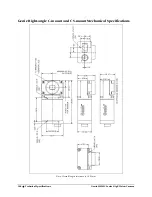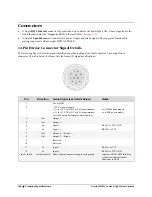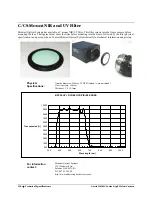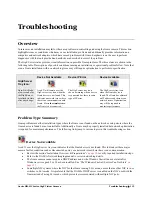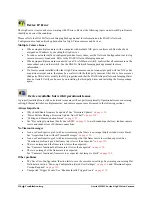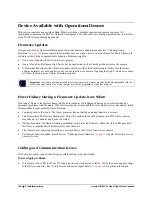
118
Technical Specifications
Genie HM-HC Series-GigE Vision Camera
Protecting Against Dust, Oil and Scratches
The sensor window is part of the optical path and should be handled like other optical components, with extreme
care.
Dust can obscure pixels, producing dark patches on the sensor response. Dust is most visible when the illumination
is collimated. The dark patches shift position as the angle of illumination changes. Dust is normally not visible when
the sensor is positioned at the exit port of an integrating sphere, where the illumination is diffuse.
Dust can normally be removed by blowing the window surface using a compressed air blower, unless the dust
particles are being held by an electrostatic charge, in which case either an ionized air blower or wet cleaning is
necessary.
Oil is usually introduced during handling. Touching the surface of the window barehanded will leave oily residues.
Using rubber finger cots and rubber gloves can prevent oil contamination. However, the friction between the rubber
and the window may produce electrostatic charge that may damage the sensor.
Scratches can be caused by improper handling, cleaning or storage of the camera. When handling or storing the
Genie camera without a lens, always install the C-mount protective cap. Scratches diffract incident illumination.
When exposed to uniform illumination, a sensor with a scratched window will normally have brighter pixels
adjacent to darker pixels. The location of these pixels changes with the angle of illumination.
Cleaning the Sensor Window
Even with careful handling, the sensor window may need cleaning. The following steps describe various cleaning
techniques to clean minor dust particles to accidental finger touches.
Use compressed air to blow off loose particles. This step alone is usually sufficient to clean the sensor window.
Avoid moving or shaking the compressed air container and use short bursts of air while moving the camera in
the air stream. Agitating the container will cause condensation to form in the air stream. Long air bursts will
chill the sensor window causing more condensation. Condensation, even when left to dry naturally, will deposit
more particles on the sensor.
When compressed air cannot clean the sensor, Dalsa recommends using lint-free ESD-safe cloth wipers that do
not contain particles that can scratch the window. The Anticon Gold 9”x 9” wiper made by Milliken is both
ESD safe and suitable for class 100 environments. Another ESD acceptable wiper is the TX4025 from
Texwipe.
An alternative to ESD-safe cloth wipers is Transplex swabs that have desirable ESD properties. There are
several varieties available from Texwipe. Do not use regular cotton swabs, since these can introduce static
charge to the window surface.
Wipe the window carefully and slowly when using these products.
Environment
Operating Temperature: 0° to 45° C (at front plate)
Storage Temperature:
-20° to 70° C
Relative Humidity:
5% to 90% non-condensing (operating)
0% to 95% (storage)
Содержание Genie HC1024
Страница 8: ...6 Contents Genie HM HC Series GigE Vision Camera ...
Страница 34: ...32 Installing the Genie Camera Genie HM HC Series GigE Vision Camera ...
Страница 94: ...92 Operational Reference Genie HM HC Series GigE Vision Camera ...
Страница 98: ...96 Network Overview Tools Genie HM HC Series GigE Vision Camera ...
Страница 104: ...102 Sapera CamExpert Guide Genie HM HC Series GigE Vision Camera ...
Страница 107: ...Genie HM HC Series GigE Vision Camera Technical Specifications 105 Genie 3D View with Right angle C mount and CS mount ...
Страница 126: ...124 Technical Specifications Genie HM HC Series GigE Vision Camera EC FCC Declaration of Conformity ...
Страница 138: ...136 Glossary of Terms Genie HM HC Series GigE Vision Camera ...



